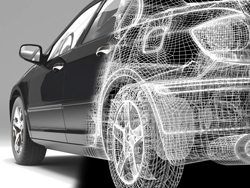Vehicle and vessel design makeover
These tiny geometric errors could affect simulation results. And incorrect simulation results could develop into potentially real-world problems which in vehicle and vessel manufacturing can prove fatal. Computer generated free-form objects, in particular, are extremely difficult to simulate with absolute accuracy because their shapes have to be approximated by simple geometric primitives. Free-form objects have well-defined and smooth surfaces except at the vertices, edges and cusps. Examples include ship hulls, propellers, and car frames for the railway and the automotive industry. To reduce and eliminate the potential for errors, one EU-funded project 'Exact geometry simulation for optimised design of vehicles and vessels' (Exciting), is bridging the gap between CAD and numerical simulation methods by using enhanced isogeometric analysis (IGA). IGA provides a new approach for the design and simulation of free-form objects. Exciting, a consortium of academic and industrial institutions from Austria, France, Germany, Greece and Norway, were particularly interested in seeing how IGA could eliminate errors in the design process of vehicles and vessels. According to project researchers, accurately designing the blades of a turbine is extremely challenging. But with Exciting's new IGA application, designers can now produce a CAD model for blades that is suitable for numerical simulation. Designers can also create an entire parametric ship-hull model that respects principal dimensions and other integral parameters. And they can now apply IGA to car components. The project, which started in 2008 and ends in 2012, is currently working on tackling some of the more theoretical challenges that underpin the development of future applications. So far, they have gained a much greater insight into the isogeometric BEM wave-resistance calculations of an immersed spheroid. They have also found a solution to a persistent 2D test problem often encountered when modelling pipes and deformable walls. And they even managed to develop a proof of concept for isogeometric design optimisation in structural mechanics. Exciting's results and continued progress will not only help the industry produce better products, but will also save them considerable time and money in their design and testing.







